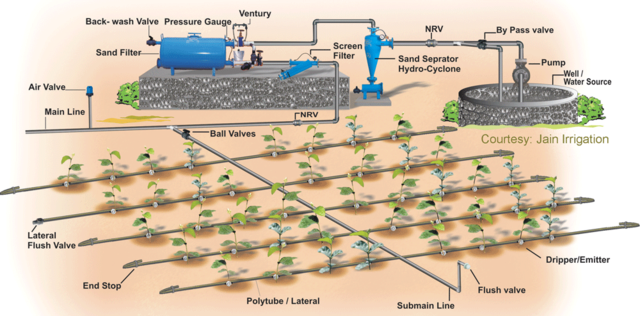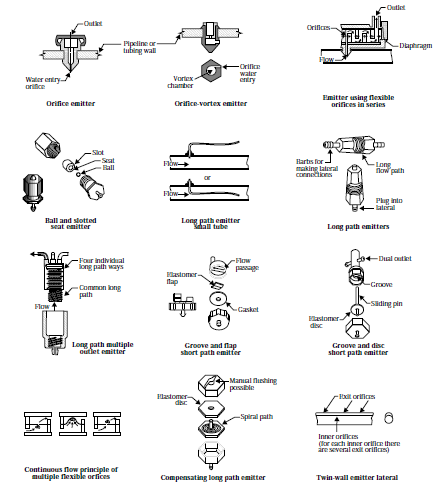Drip Irrigation: Difference between revisions
Jump to navigation
Jump to search
No edit summary |
No edit summary |
||
| Line 1: | Line 1: | ||
[[File:DripIrrigation.png|640px|thumb|right| Drip Irrigation Layout and its parts. ]] | [[File:DripIrrigation.png|640px|thumb|right| Drip Irrigation Layout and its parts. ]] | ||
Drip irrigation saves water and fertilizer by allowing water to drip slowly to the roots of plants. | Drip irrigation is the targeted delivery of water to plants along water distribution lines emanating from a central water reservoir. Drip irrigation saves water and fertilizer by allowing water to drip slowly to the roots of plants. | ||
Typical components for a micro irrigation system include the reservoir, control valve, filter, main pipe, lateral pipe, and micro-tube/emitter. This type of system covers an area between 20 m2 and 1000 m2. The layout of each drip irrigation system is highly variable, dependent on the crop and field. Many emitters exist with different methods of water impedance, including vortex, tortuous path, long path, and groove and disk short path. | |||
==Other Pages== | |||
*Related: [[Subsurface Drip Irrigation]] | |||
*Appropedia: [http://www.appropedia.org/Drip_irrigation Drip Irrigation] | |||
*Appropedia: [http://www.appropedia.org/CCAT_Gravity_fed_drip_irrigation CCAT Gravity fed drip irrigation] | |||
[[Image:emitter_types.png|thumb|left|upright=3|Emitter types, U.S. Department of Agriculture.]] | |||
[[Category:Food and Agriculture]] | [[Category:Food and Agriculture]] | ||
Revision as of 06:52, 14 August 2016
Drip irrigation is the targeted delivery of water to plants along water distribution lines emanating from a central water reservoir. Drip irrigation saves water and fertilizer by allowing water to drip slowly to the roots of plants.
Typical components for a micro irrigation system include the reservoir, control valve, filter, main pipe, lateral pipe, and micro-tube/emitter. This type of system covers an area between 20 m2 and 1000 m2. The layout of each drip irrigation system is highly variable, dependent on the crop and field. Many emitters exist with different methods of water impedance, including vortex, tortuous path, long path, and groove and disk short path.
Other Pages
- Related: Subsurface Drip Irrigation
- Appropedia: Drip Irrigation
- Appropedia: CCAT Gravity fed drip irrigation

